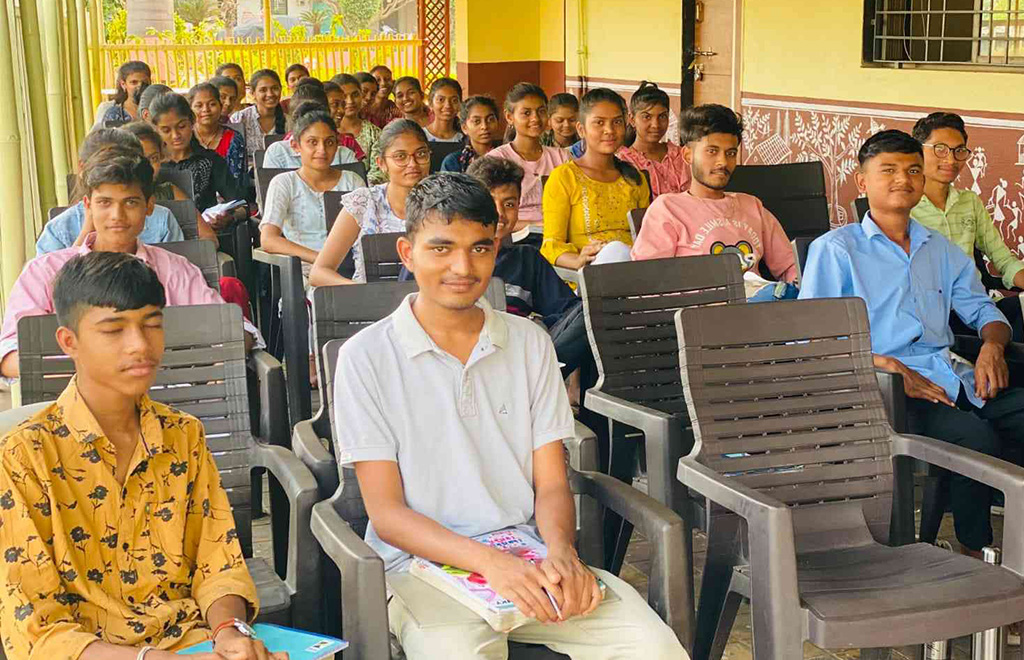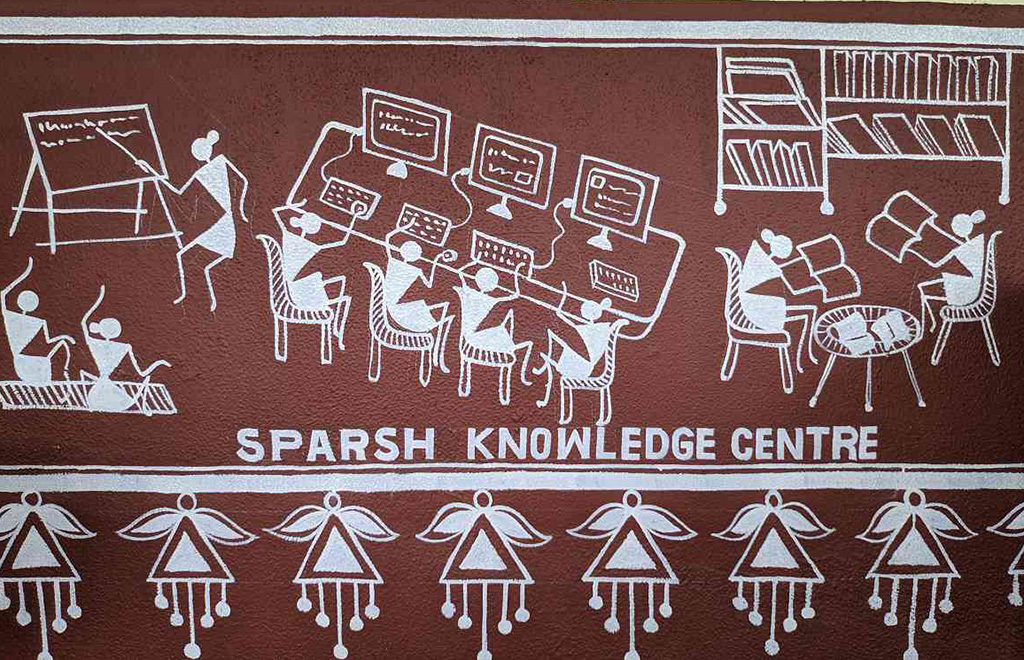In South Gujarat’s Adivasi areas, a network of community-funded libraries is helping bridge the gaps left by the education system.
By Nolina Minj
The village of Galkuva lies deep in the heart of southern Gujarat, in the Tapi district. On July 16, light droplets of rain pattered down as we made our way to a spacious mud house amidst fields of freshly sown paddy and verdant sugarcane. On the porch, young children sat on the ground playing carrom, a local tabletop game. Inside were two rooms divided by a wall, with long tables and several chairs occupied by children playing chess or doing homework and older youth poring over heavy textbooks. The sides of the rooms were lined with large steel and glass cupboards containing scores of books. A lone portrait of Dr. BR Ambedkar from the back wall gazed down at the children.

“We are yet to put up portraits of Birsa Munda and Tantia Bhil,” said 27-year-old Hardik Gamit, naming the two Adivasi freedom fighters, revered in the Adivasi-dominant district. According to the 2011 census, almost 85% of Tapi’s population was categorized as Scheduled Tribes.
The mud house serves as a library for the children and youth of Galkuva and neighboring villages. It is open from 8 each morning to 9.30 at night.
Hardik set up the library in August 2022 with the support of like-minded youth in the village. Before that, for two-and-a-half years, he and others had been helping youth in the neighborhood prepare for government exams in a classroom at the local primary school and a disused poultry farm. For years, Hardik had wanted to open up a library space. “When I was preparing for exams, there were no decent library spaces nearby,” Hardik said. “I went to Surat [another city in Gurajarat] with my brother to study. This was possible because we could afford it, but most people cannot.”
In July 2022, an Adivasi couple from Galkuva who are teachers and live 14 km away donated the house to Hardik and his group for their use. A month later, he and his team launched the library.
“We coach those who can’t afford being coached at all; they can’t even afford to go to Vyara – the closest city from here,” said Hardik, who has a bachelor’s degree in mechanical engineering and works as a supervisor at the Industrial Training Institute in Dang, 60 km away. The coaching efforts are slowly reaping success: two young people have landed jobs, one as a junior clerk and another as a police constable.
After the library’s launch, younger schoolchildren from Galkuva and surrounding villages also asked to be allowed to use the space. So, the older youth decided to start tutoring them in the evenings, from Monday to Saturday, after they had finished their studies. “While helping people with exam preparation, I realized that if we paid attention to kids from a young age, we’d have to worry less later,” Hardik said.
He explained, “Our tribal people from villages don’t aim for higher-level exams like GPSC or UPSC,” referring to the Gujarat and the Union Public Service Commissions. He added that the main reason was that they attended government schools where the teaching was of poor quality and didn’t give children a solid educational foundation.
“Children then become disinterested in studies because they don’t understand anything and fail to plan for their future,” he said. “Now that we’re coaching them at a young age, many have decided to apply for IAS or IPS,” he added, referring to the Indian Administrative and Police Services. “I see that happening in the coming years.”
Hardik manages expenses such as electricity with the support of around 20 working youths from Galkuva and the surrounding areas. The group also ensures children are safely dropped back to their homes in a pickup truck owned by one of the youths.

Hardik and his peers’ efforts are not isolated. Over the past five years, Adivasis from the Chaudhari, Gamit, and Vasava communities have organized 60 such libraries and coaching centers in the Adivasi-dominant villages of Surat, Tapi, and Valsad districts in Gujarat.
While each library is independently run by concerned local youth, a collective of well-to-do Adivasis in Vyara, the district headquarters of Tapi, have come together under the banner of the NGO Sparsh Knowledge Centre to provide support with furniture, books, stationary, and other expenses. The organization typically identifies individuals or groups already serving their community and encourages them to find an unused space to set up a library.
“Most of our people work in agriculture or wage labor and don’t have much of an idea about education,” said Bipin Chaudhari, a founding member of Sparsh. “Their children need additional support to find jobs. They are unable to afford to travel to big cities and study there. We thought that if libraries were available, they could study near their homes.”
“While Galkuva’s library was the only one that Scroll visited where schoolchildren are also tutored, youths associated with the Sparsh network are also helping younger children in other villages. Bipin explained that in many other villages, Sparsh had encouraged the young people who studied for exams at the libraries to visit local government schools to teach primary school children.”
He added that the work receives steady financial contributions from older members of the communities. “The people who struggled on their own and made something out of themselves, they are now giving back,” he said.
“The emergence of these community-driven libraries in southern Gujarat is particularly significant, given the contentious history of Adivasi education in the state.”
The idea of focused education for children from Adivasi communities was first formally implemented in Gujarat before Independence. According to a paper by Bipin Jojo, an Adivasi academic, in 1922, the Gandhian activists Indulal Yagnik and Thakkar Bapa set up the first residential school, known as an ashram shala, in Mirakhedi village in Gujarat’s Dahod district. In 1923, Bapa founded the Bhil Seva Mandal, an organization devoted to the welfare of tribals, which opened more residential schools in the district. Over time, Bapa expanded his social work activities into Bihar, Madhya Pradesh, Rajasthan, Maharashtra, and Odisha, opening ashram shalas in several areas of those states.

According to a 2014 report from the Ministry of Tribal Affairs, the government took over the task of opening ashram shalas for tribal children after independence in the 1950s.
Scholars have documented how these schools were largely run on the Gandhian philosophy of Nai Talim, or basic education, under which vocational work such as farming and spinning yarn on the charkha was an integral focus of the education.
Over the years, Adivasi scholars have sharply criticized these schools for segregating Adivasi children from their families and cultural milieu and for imposing upper-caste Hindu culture on them. The 2014 report, whose lead author was the academic Virginius Xaxa, stated that the guiding principle of these schools was the idea that “tribal people were savage and wild” and “needed to be civilized by the means of education outside the tribal social and cultural life.”
The report described the program as the “Ashramization of the whole tribal education program.”
In a 2020 book chapter, sociologist JC Patel noted that the ashram schools in Gujarat that used the Nai Talim system neglected teaching of science, mathematics, and English language. Since the 1960s, the tribal middle class resented this.” He noted that many middle-class Adivasis felt that this education model “restricted their chances of competing with the non-tribals for new opportunities.”
The report noted that this problem continues to the present day. It argued that Adivasis in Gujarat are “poor amid prosperity.”
Indeed, a 2017 World Bank report observed that Scheduled Tribes in Gujarat “have a very high incidence of poverty and slower poverty reduction than other social groups in the state.” Citing 2012 National Sample Survey data, it noted that they were the social group with the largest percentage, 36%, living below the poverty line. Illiteracy was also the highest amongst Scheduled Tribes, at 44%.
Patel’s report linked the problems faced by tribal people to the poor state of education, noting that “tribals lag in education and, hence, are deprived of new opportunities emerging in the modern sectors.”
Activists’ and experts’ arguments about the failure of education programs to serve Adivasi communities rang true when I visited the library at Gadat village in Tapi on July 15. I met several students in their mid-twenties who belonged to agricultural families. Most are the first in their families to pursue higher education and apply for steady jobs.
The role of the village’s library in filling the gap left by the government was apparent from the students’ stories. Established in 2019, the Gadat library was the very first of the Sparsh network. The Gujarat Electricity Board owned the previously abandoned single-story building. Well-off village members came together and renovated it with the aid of corporate social responsibility funds from ONGC. The library opens at 7 in the morning and closes at 11.30 each evening – students preparing for exams for jobs come and go according to their schedules. The inside walls are decorated with blocks of Warli art and portraits of Adivasi and Bahujan icons. Two large tables span the rectangular room, lined with several chairs.

Ashish Gamit, who is 26 years old and has a bachelor’s degree in agricultural studies and a master’s in social work, is among those who use the library to prepare for exams – in his case, to become an agricultural officer. Ashish explained that in government schools of the region, it was not uncommon for a single teacher to be handling students from three different classes. He mentioned that the local school nearby only had four teachers for classes one to eight. “You need at least one teacher per standard for a proper education,” he said.
Rahul Chaudhari, 27, from the neighboring Jesingpur village, has been coming to the library since 2021. As a child, Rahul’s family shifted to Surat, seeking better financial prospects. Rahul studied up to Class 6 in his village—because the quality of education was fairly poor, he felt he had much to catch up on when he started school in the city. In Surat, he worked in the diamond industry as a diamond cutter for eight hours every day and studied only after that.
In 2021, having secured some financial resources, Rahul and his parents returned to the village. Rahul was determined to keep up his education and eventually secure a well-paying job. “Farming and cattle-rearing are the two main sources of income here, which aren’t always enough to run a household,” he said.
He is studying to become a police officer and spends six to eight hours a day at the library, absorbed in his books. “Nobody in my extended family is working a steady job,” he said. “I feel if I get one, others may follow. Things will improve for the coming generations.”
All the students I spoke with were grateful for the library space. Many said their home atmosphere wasn’t conducive to prolonged study with undivided attention. “At home, there’s always some work or the other that comes up, so we can’t study uninterrupted,” said Rahul.
This was particularly true in the case of Manoj Gamit, who is 24, and whose father died during the second wave of COVID-19—this left him with the primary responsibility of looking after his family, comprising his mother and younger brother.
His schedule differs according to the seasons—when I visited, since it was sowing season, Manoj’s day began at 6 am each day. He worked on his farm until 5 pm, reached the library around 7 pm, and stayed until 11 pm. He has a bachelor’s degree in Gujarati and is studying to become a multi-purpose health worker. “My schooling was okay,” he said. “But we never got guidance about what to study to become employable later. We receive such guidance at the library now. We’re even given the necessary books. We’re taught about our community and how we need to work hard and give back to it.”
Besides Gadat, the village whose youth have had the greatest success in clearing government exams and securing jobs is Nani Bhatlav in Surat district. The resident behind the village’s library is 26-year-old Ankit Chaudhari, who currently has a furniture and fabrication business in the village.
In 2021, inspired by the start of other libraries, Ankit mortgaged his bike to obtain a loan to renovate the village community hall and turn it into a library. In the two years since, 23 youths from the village and surrounding areas have successfully passed various government exams, including for the police, the forest department, and the state electricity board.
“People in the village survive on agriculture and animal husbandry,” said Ankit. “There is no suitable atmosphere for studying. The nearest library is at least an hour away by bus.” He noted that the youth of his generation did not get the guidance and support they needed. “I got a BCom (Bachelor of Commerce) degree but couldn’t study more because of financial issues,” he said. “So I thought I should do something for the youth.” Through his fabrication business, he also provides low-cost tables to other libraries in the Sparsh network.
As renovation expenses increased, the block development officer encouraged Ankit and his team to apply for a grant under the state government’s Vatan Prem scheme for rural development in Gujarat. The application was selected, and under the scheme, the state government covered 40% of the expenses for setting up the library. In comparison, Ankit and his team secured 60% from private funds raised by the board of an ashram school in Bardoli.
A year and a half ago, Ankit was elected to be the sarpanch of his village. After this, he expanded his efforts.
This story was originally published in Scroll (India) and is republished within the Human Journalism Network program, supported by the ICFJ, International Center for Journalists.
